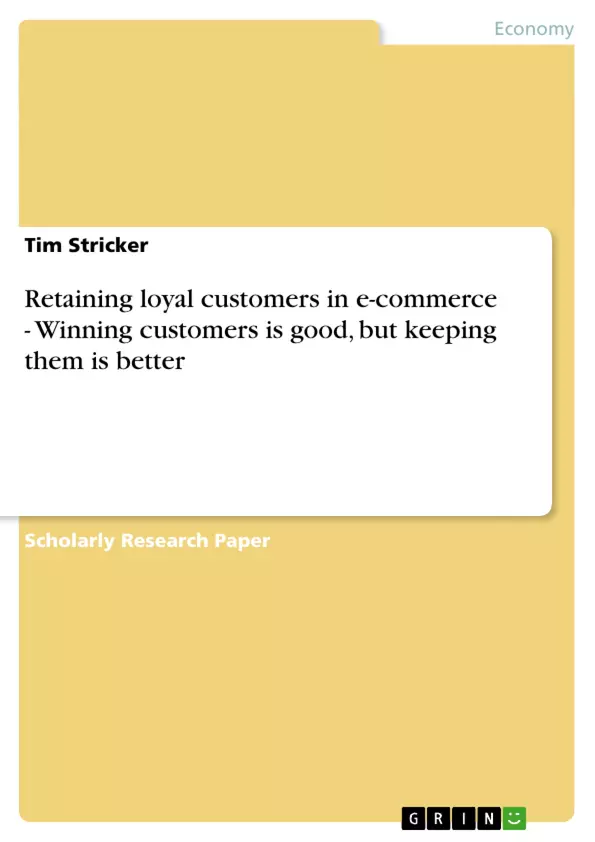“I know who you are, I remember you. I get you to talk to me. And then, because I know something about you, my competitors don't know, I can do something for you my competitors can't do - not for any price.” (Newell, 2000)
In today’s business there is a shift of many companies away from a transactional mindset toward a relational mindset when it comes to dealing with customers. That is because researches proofed that nowadays for many companies profitability depends on the companies ability to develop and maintain long-term relationships with their clients (e.g. Lemon et al., 2002, pp.1-14). In order to gain a competitive edge, companies need to be customer-driven and able to serve their customers needs. Moreover, companies have to deliver a certain added value to exceed customer expectations and build strong relationships.
In the traditional market, where face-to-face contact is possible, marketers get to know their clients personally. By personal contact, marketers have the possibility to build a personal relationship with their clients, figure out their needs and finally satisfy their needs by personalized services. As a result, customers are likely to stay with a company and the potential that they become loyal increases.
However, the emergence of the internet and e-commerce makes it is very difficult for companies to build long-term relationships with customers. By means of the internet the personal contact to customers is abolished and a reduction of transaction costs is enabled, which in turn creates a new set of customer expectations. Therefore, the potential that customers will switch to the competition rises dramatically compared to traditional markets. This is because customers now have access to millions of different companies and they can easily compare different products 24 hours and seven days a week.
In order to maintain strong customer relationships in the internet era the modified customer expectations need to be identified. Companies need to figure out what is influencing the satisfaction of customers and how to create loyalty. Competitive forces have to be considered to safeguard the business success. Furthermore, relationship bonds need to be created to encourage customers to remain in a relationship. All of the above will be examined within this report.
Inhaltsverzeichnis (Table of Contents)
- Summary
- Introduction
- Project description
- Problem definition
- Project assignment
- Objectives
- Customer Relationship Management
- Customer Relationship Marketing
- Understanding customer satisfaction
- The relationship between satisfaction and loyalty
- Benefits of customer retention
- Benefits for buyers
- Benefits for marketers
- The digital age
- E-business
- E-CRM
- Buyer and marketer values
- Values to buyers
- Values to marketers
- Online customer expectations
- How to retain customers in E-business
- Service quality
- Database marketing
- Personalization by collaborative filtering
- Customer integration
- Partner programs
- Virtual communities
- Recovering from service failures
- Handling competitive forces
- Practical application
- Initiation
- Amazon best practice
- Customer retention at Amazon.com
- Conclusion
- Bibliography
- List of Figures
- List of Tables
- Appendix 1
Zielsetzung und Themenschwerpunkte (Objectives and Key Themes)
This report aims to explore the crucial role of customer retention in the e-commerce landscape. It focuses on understanding why retaining loyal customers is a more cost-effective strategy than acquiring new ones and investigates how companies can build and maintain long-term customer relationships within the challenging online environment.
- The importance of customer retention in e-commerce
- The impact of the internet on customer relationships and expectations
- The connection between customer satisfaction and loyalty
- Strategies and tools for building loyalty in online markets
- The influence of competitive forces and service failures on customer retention
Zusammenfassung der Kapitel (Chapter Summaries)
- Introduction: This chapter introduces the topic of customer retention in e-commerce, highlighting the shift from transactional to relational customer relationships. It emphasizes the importance of understanding and meeting customer expectations in the online environment.
- Project description: This chapter defines the problem of unpredictable and insecure revenues for internet-based companies due to the challenges of retaining customers in the online market. It outlines the project assignment and objectives, focusing on developing strategies for retaining loyal customers in e-commerce.
- Customer Relationship Management: This chapter delves into the principles of Customer Relationship Management (CRM), focusing on customer relationship marketing, understanding customer satisfaction, and the relationship between satisfaction and loyalty. It also examines the benefits of customer retention for both buyers and marketers.
- The digital age: This chapter explores the impact of the digital age on e-commerce and customer relationships, discussing concepts like e-business, e-CRM, and buyer and marketer values in the online environment. It examines the unique expectations of online customers and explores strategies for retaining customers in e-business, including service quality, database marketing, personalization, and customer integration.
Schlüsselwörter (Keywords)
The report primarily revolves around the concepts of customer retention, e-commerce, customer relationship management, online customer expectations, satisfaction, loyalty, and strategies for building and maintaining long-term customer relationships in the digital age.
- Arbeit zitieren
- Tim Stricker (Autor:in), 2007, Retaining loyal customers in e-commerce - Winning customers is good, but keeping them is better, München, GRIN Verlag, https://www.grin.com/document/85346



